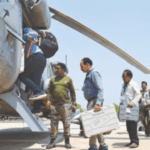DUBAI: The Middle East’s financial hub was clogged on Wednesday, and two days later, UAE highways were still flooded and the country’s main airport was in disarray.
After slamming Oman, where 18 people, including children, lost their lives, storms struck the Emirates, Bahrain, and the Gulf of Arabia overnight on Monday and Tuesday.
At least one 70-year-old man was murdered, according to UAE police, when his automobile was washed away in Ras Al-Khaimah, one of the seven oil-rich emirates of the nation. There were reports of power disruptions in and around Dubai, which was peppered with flooded regions as well as abandoned and sunken cars.
A few meters below the surface, a road tunnel close to the airport was totally submerged in water.
It was “highly likely,” according to climatologist Friederike Otto, a specialist in determining how climate change affects extreme weather events, that the storms were made worse by global warming.
To enhance rainfall, the UAE regularly carries out cloud seeding activities. Seven cloud seeding operations had taken place in the days preceding the storm, according to what Bloomberg had previously stated.
“We did not use cloud seeding because (the storm) was already strong,” a senior weather forecaster from the Gulf state’s National Centre of Meteorology clarified in response to claims that the UAE was using cloud seeding, which involves spraying chemicals to boost rainfall.
The national meteorological center reports that Al Ain, a city on the UAE-Oman border, had record rainfall in the UAE, with 254mm pouring in less than 24 hours.
Prior to the UAE’s formation in 1971, records go back to 1949, and that amount was the highest. Following the 259.5 mm of rain, huge lineups of cars were seen on the flooded six-lane motorways.
Response to an emergency
As the sun came out again, reports of people being left overnight in their cars and offices due to heavy downpours and rolling black clouds started to surface.
Significant damage was seen around the nation, including collapsed roads and flooded homes, according to local media and photos on social media. Hours after the intense rain stopped, rescue personnel attempted to drain flooded roadways throughout the nation, but it was not immediately apparent how much damage had been done.
The UAE lacks a large portion of the drainage infrastructure required to withstand prolonged rain. It is not unusual for roadways to become partially flooded after prolonged downpours. Usually, it only rains a few times a year.
According to state news agency IRNA, Iranian authorities claimed to have saved 21 crew members from Sri Lanka from a tanker flying the flag of the Cook Islands that was sinking in the Gulf of Oman. According to the source, the unidentified tanker sustained damage about 50 kilometers off the Iranian coast of Jask. Jask emergency services provided medical attention to five crew members, all of whom recovered physically. It did not, however, specify the time of the rescue.
overseas journey
Due to heavy rains, Emirates Airline’s hub, Dubai International, reported major delays, including delayed or diverted aircraft. Due to floods caused by Tuesday’s rainfall in Dubai and other parts of the UAE, the airport had to temporarily halt operations.
The major airline of Dubai, Emirates, canceled all check-ins as employees and customers found it difficult to come and depart, causing access roads to flood and some metro services to be suspended. Long taxi lines snagged at the airport, and travelers gathered there, many of them getting angrier by the minute as almost every flight was constantly delayed.
After a 12-hour wait, a passenger who wished to remain anonymous said, “They are completely lost, its complete chaos — no information, nothing.”
around the same time, a sizable group of people congregated around a connecting desk, applauding and whistling in disapproval of the lack of details.
Due to Tuesday’s intense rain, numerous flights were canceled, delayed, and diverted.
Although it stated that it would take some time to recover, Dubai International Airport was attempting to get back to regular operations as soon as possible.
Crew displacement has caused delays and diversions in flights, according to a statement from DXB. In a social media post, the airport—which is also the busiest international travel hub in the world—advised passengers in Dubai not to visit the airport.
According to Emirates Airline, processing of passengers who are already en route to Dubai will not stop.
Separately, Egypt Air announced in a statement that they would no longer be operating flights between Cairo and Dubai. According to the airline, operations on this route will not resume until the UAE’s weather improves.








